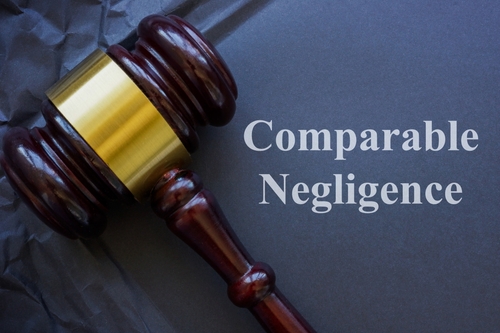John Austin | August 19, 2025 | Personal Injury

Florida’s 51% fault rule means you cannot receive compensation if an accident is mostly your fault. An accident on a St. Petersburg street already brings many challenges, and Florida’s 2025 modified comparative negligence law adds another layer of complexity. A Clearwater personal injury lawyer helps you face this system. They present the facts of your case to protect your right to seek compensation.
This law changed in 2023, marking a significant shift in how personal injury cases play out. The new standard makes the evidence of what happened in your accident case even more valuable.
This fault rule has major implications for anyone involved in an accident in Florida, from a car crash on I-275 to a slip and fall in a Clearwater store.
Key Takeaways
- Florida’s law now bars you from compensation if you’re found 51% or more responsible for an accident.
- Insurance adjusters use this 51% rule to try to shift blame onto you to avoid paying claims.
- The strength of your evidence, like photos and witness statements, counters an unfair blame assessment.
The Old Law vs. The New Law in Florida
Before March 2023, Florida used a different system for responsibility and compensation. Introducing the modified comparative negligence system created a new reality for accident victims. A Free Lawyer Consultation can help you understand how these changes affect your case and what steps you should take next.
Pure Comparative Negligence: The Previous System
Florida previously followed a pure comparative negligence rule. Under that system, you had a path to recover damages even if you were mostly at fault. For example, if you were found 90% responsible for a car accident, you could still collect 10% of your damages.
The old system allowed for a financial recovery for nearly any injured person who wasn’t entirely at fault. Insurance companies paid out a portion of damages based on their policyholders’ percentage of fault. This approach provided a measure of relief to many people hurt in accidents.
Modified Comparative Negligence: The Current System
Florida now uses a modified comparative negligence system. This change came as part of a larger tort reform bill signed into law on March 24, 2023. The new approach is much stricter for people seeking compensation after an accident.
Under Florida’s modified comparative negligence law, your ability to recover damages stops if you are found to be 51% or more at fault. If a jury or judge decides your share of the blame is 50% or less, you may receive compensation. However, the amount you get is reduced by your percentage of fault. This change to the fault law in Florida places a heavy burden on the injured party.
What Florida’s Shift in Fault Means for You
The switch to a modified comparative negligence system directly impacts your injury claim. It alters how you need to approach your case from the very beginning. It also changes how insurance companies evaluate claims. Insurance Company Play a Role by using the 51% rule to limit payouts, often trying to shift more blame onto injured victims.
The 50% Threshold: A Clear Line
The most significant feature of Florida’s modified comparative negligence law is the 50% threshold. Being 50% at fault versus 51% at fault is the difference between receiving some compensation and receiving none at all.
This fine line makes the determination of fault the central battleground in many personal injury cases.
Imagine an accident on Gulf to Bay Boulevard in Clearwater; the total damages are valued at $100,000. If you’re found 50% at fault, you may receive $50,000. But if you’re found 51% at fault, you receive $0 under Florida’s 51% bar.
This rule means the other party’s insurance company has a strong incentive to shift just enough blame onto you to cross that threshold. Even a single percentage point in the fault calculation makes all the difference.
This aspect of the modified comparative fault in Florida adds immense pressure to your claim.
How Insurance Companies Respond to the Change
Insurance adjusters are very aware of Florida’s 2025 modified comparative negligence law. They use it as a tool in their negotiations. They aim to pay out as little as possible on a claim, and the new rule helps them do that.
You may find that an adjuster is quick to assign blame to you. They may ask leading questions or try to get you to admit partial fault in a recorded statement. They know that if they build a case showing you are more than 50% responsible, their company avoids paying the claim entirely.
Here’s how insurers often adjust their strategies:
- Aggressive Fault-Finding: They immediately look for any action you took that might have contributed to the accident.
- Lowball Settlement Offers: An insurer may make a low offer early on, claiming you bear significant fault and that the offer is generous given the risks of the modified comparative negligence system.
- Denial of Claims: They’re more likely than ever before to deny claims outright by arguing your fault is over the 50% limit.
- Delayed Investigations: Sometimes, insurers drag out an investigation, hoping you give up or make a mistake that harms your case.
Dealing with an insurer under Florida’s modified comparative negligence rule requires a solid strategy and a firm grasp of the facts.
4 Steps To Take After an Accident Under Florida’s New Rules
What you do immediately after an accident has always been significant in terms of your chances of maximising compensation. With the strictness of Florida’s 51% fault rule, those first actions are even more defining for your case.
Take these four steps:
- Obtain the Official Report: You need a copy of the formal report from your accident. For a car crash, get the police report from the responding law enforcement agency, such as the Pinellas County Sheriff’s Office or Tampa Police Department. If you fell on a commercial property, like a store in the Westfield Countryside Mall, contact the business’s management to request a copy of the incident report they created.
- Organize All Your Evidence: Gather all the information you have related to the accident. Collect any photos or videos you took at the scene and the contact information for witnesses. Write down a detailed account of everything you remember about the incident, from the moments leading up to it to what happened immediately after. Keep any damaged personal items, such as torn clothing or a broken phone, as they serve as evidence.
- Prepare for Calls From the Insurance Company: An insurance adjuster for the other party will likely contact you at home. When they do, avoid giving a recorded statement or guessing about who was at fault. Statements like “I should have paid more attention” will be used to assign more blame to you. Politely decline to discuss the details and direct them to your attorney.
- Contact a Personal Injury Attorney: Connect with a Clearwater personal injury lawyer to get guidance for your claim. An attorney helps protect your rights and takes over communication with the insurance companies.
Examples of Modified Comparative Negligence in Action

Real-world scenarios show how Florida’s modified comparative negligence law functions. These examples illustrate how the 51% rule plays out in common accident types. Each case hinges on the specific facts and the evidence presented to establish fault percentages.
A Car Accident on Dale Mabry Highway
A driver is making a left turn on a green light from a busy Tampa road like Dale Mabry Highway, but an oncoming car runs a red light and hits them. At first, this seems like a clear case where the red-light runner is 100% at fault. Should I Hire a Lawyer? Yes, an attorney can challenge attempts to shift blame onto you and protect your right to compensation.
However, the insurance company for the at-fault driver finds a witness who says the turning driver seemed to be going a little fast for the intersection. The insurer uses this statement to argue that the turning driver is partially responsible for the accident.
Their goal is to push the percentage of fault past the 50% mark to deny the claim based on the modified comparative negligence system.
A Clearwater personal injury lawyer for the turning driver would challenge this by finding other witnesses or using other evidence to show their client acted reasonably.
A Slip and Fall at a Clearwater Beach Shop
A person is shopping in a beachfront store in Clearwater, slips on a small puddle of water near a leaky cooler, and suffers a serious injury. The store’s owner argues that the puddle was obvious and that the injured person must have been distracted or not been watching where they were walking.
The store (and its insurer) attempts to place more than half the blame on the customer to avoid paying for the victim’s medical bills. A lawyer for the injured shopper would gather evidence to counteract this claim.
This evidence may include:
- Video Surveillance: Security footage may show how long the puddle was there and if any employees walked past it without taking action.
- Witness Testimony: Other shoppers or employees may confirm the hazard’s presence.
- Maintenance Logs: These documents may reveal a history of the cooler leaking, proving the store was aware of a recurring problem.
- Store Policies: The store’s own safety procedures might show that employees failed to follow protocols for regular inspections.
How a Personal Injury Lawyer Helps With Your Claim
A personal injury lawyer becomes your advocate in the complex environment created by Florida’s modified comparative negligence law. They work to build a case that clearly shows the other party holds the majority (if not all) of the responsibility for your injuries.
The Investigation
Your Clearwater personal injury lawyer initiates a thorough investigation right away, which becomes foundational to challenging an insurance company’s attempt to shift blame. It’s a proactive step to get ahead of the defense’s arguments about your portion of fault.
Your legal team finds and secures all available evidence, including police reports, witness statements, photographs, and video footage from traffic cameras or nearby businesses. They can send preservation letters to make sure that at-fault parties don’t destroy any relevant evidence.
Managing Communications
Once you hire an attorney, all communication with insurance companies goes through their office. This stops adjusters from contacting you directly. You won’t have to worry about saying the wrong thing in a recorded statement.
Your lawyer handles all negotiations on your behalf. They know the tactics insurers use, especially regarding Florida’s 51% fault bar. Your legal team builds and presents a compelling case to the adjuster that is designed to demonstrate that the other party’s fault is well above yours.
Working With Outside Professionals
Strong personal injury cases often rely on the opinions of outside professionals. Law firms have networks of respected individuals they bring in to analyze the facts of a case. These opinions add weight to your claim and are hard for insurance companies to dismiss.
These professionals may be accident reconstructionists who can show how a crash occurred, medical illustrators who create visuals of your injuries for a jury, or engineers who may find a product defect or a dangerous road condition. How You Can Sue depends on proving negligence, gathering strong evidence, and filing your claim within Florida’s statute of limitations.
Representing Your Interests in Court
Your lawyer’s ultimate goal is to secure fair compensation for your injuries and losses. If the insurer refuses to be reasonable, your lawyer can present your case to a judge and jury. They’ll argue on your behalf and work to secure a verdict that holds the correct party responsible for your harm.
FAQ for Florida’s 2025 Modified Comparative Negligence Law
How Is the Percentage of Fault Determined in a Florida Injury Case?
A claims adjuster, a judge, or a jury determines the percentage of fault. They look at all the evidence from an accident, including police reports, witness accounts, photos, and expert testimony. They weigh the actions of everyone involved and assign a percentage of responsibility to each person.
Your Clearwater personal injury lawyer challenges the adjuster’s initial assessment with evidence like police reports, witness accounts, and expert testimony to show the other party was truly at fault. If an agreement isn’t reached, a judge or jury decides after hearing both sides.
What Happens if I Am Exactly 50% at Fault for My Accident?
You may still recover damages if you’re found to be exactly 50% at fault. Florida’s law cuts off recovery only if you are found to be 51% or more at fault. If you’re 50% responsible, your final compensation award is reduced by your 50% share of the fault.
Does the Modified Comparative Negligence Law Affect All Types of Injury Claims?
Yes, this law applies to most negligence-based personal injury cases in Florida. This includes claims from car accidents, truck accidents, slip and falls, and other premises liability incidents. The 51% bar for recovery is a standard that applies broadly across these cases. Roman Austin Car Accident and Personal Injury Lawyers are here to guide you through these rules and fight for the compensation you deserve.
How Does Florida’s 2025 Modified Comparative Negligence Law Impact My Potential Compensation?
This law directly impacts your compensation by reducing it based on your assigned fault. For instance, if you are awarded $200,000 in damages but found 20% at fault, your recovery is reduced by $40,000 (20%), leaving you with $160,000.
If your fault is determined to be 51% or greater, you do not recover any compensation.
Is There a Time Limit To File My Claim Under These New Rules?
Yes, the same 2023 law that introduced modified comparative negligence also changed the statute of limitations for general negligence claims. The deadline to file a lawsuit was reduced from four years to two years from the date of the accident.
Your Path Forward After an Accident

An accident creates enough disruption in your life. The law shouldn’t add to your burdens, but the reality is that Florida’s fault rules are complex and have high stakes. You don’t have to face this challenge alone.
A dedicated personal injury law firm helps you establish the facts. They fight back when an insurance company tries to use the 51% rule to unfairly deny your claim. Contact the attorneys at Roman Austin Car Accident and Personal Injury Lawyers at (727) 787-2500 for a free consultation to talk about the details of your case.


